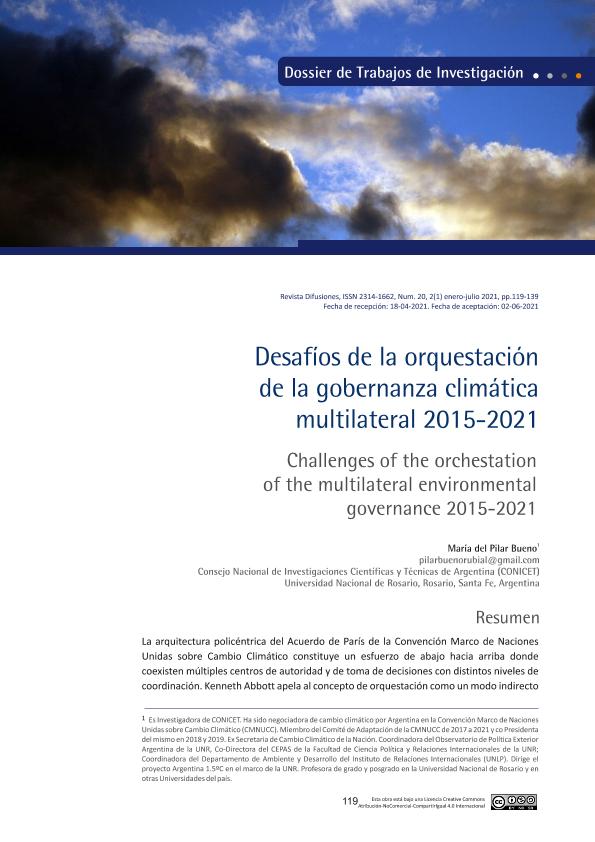Artículo
La arquitectura policéntrica del Acuerdo de París de la Convención Marco de Naciones Unidas sobre Cambio Climático constituye un esfuerzo de abajo hacia arriba donde coexisten múltiples centros de autoridad y de toma de decisiones con distintos niveles de coordinación. Kenneth Abbott apela al concepto de orquestación como un modo indirecto de gobernanza basado en incentivos suaves y controles no obligatorios. Se analiza el comportamiento de la CMNUCC como orquestador de la gobernanza climática teniendo en cuenta un doble rol estratégico y en qué medida ha podido ser efectivo en cada una de estas posiciones. Por un lado, movilizando los esfuerzos estatales hacia un mayor compromiso y acción conforme a la particular naturaleza del Acuerdo de París. Por otro lado, si ha buscado -y si lo ha logrado- constituirse en orquestador de otros actores y esfuerzos no estatales y subestatales en tres campos concretos que hacen a las metas colectivas de la arquitectura climática actual: la meta de temperatura y el uso de la transparencia como herramienta de acción indirecta; la meta global de adaptación y el Balance Mundial y la meta de largo plazo de financiamiento en sus dimensiones individual y colectiva. El artículo asume un diseño descriptivo-analítico y para ello emplea técnicas cualitativas de recolección y análisis de la información incluyendo el fichaje y análisis de documentos a partir de fuentes primarias y secundarias. El recorte temporal involucra el período 2015 a 2021. The polycentric architecture of the Paris Agreement of the United Nations Framework Convention on Climate Change constitutes a bottom-up effort where multiple centers of authority and decision-making coexist with different levels of coordination. Kenneth Abbott appeals to the concept of orchestration as an indirect mode of governance based on soft incentives and non-mandatory controls. The behavior of the UNFCCC as an orchestrator of climate governance is analyzed, taking into account a double strategic role and to what extent it has been effective in each of these positions. On the one hand, mobilizing state efforts towards greater commitment and action in accordance with the particular nature of the Paris Agreement. On the other hand, if it has sought -and if it has succeeded- to become an orchestrator of other non-state and sub-state actors and efforts in three specific fields that make up the collective goals of the current climate architecture: the temperature goal and the use of transparency as a tool for indirect action; the Global Goal on Adaptation and the Global Stocktake, and the long-term goal of finance considering both the national and collective dimensions. The article assumes a descriptive-analytical design and it uses qualitative techniques for the collection and analysis of information, including the analysis of documents from primary and secondary sources. The article comprises the period 2015 to 2021.
Desafíos de la orquestación de la gobernanza climática multilateral 2015-2021
Título:
Challenges of the orchestation of the multilateral environmental governance 2015-2021
Fecha de publicación:
06/2021
Editorial:
Universidad Católica de Santiago del Estero. Departamento Académico San Salvador
Revista:
Difusiones Revista Digital
ISSN:
2314-1662
Idioma:
Español
Tipo de recurso:
Artículo publicado
Clasificación temática:
Resumen
Palabras clave:
GOBERNANZA POLICENTRICA
,
ORQUESTACION
,
CAMBIO CLIMATICO
,
NEGOCIACIONES
Archivos asociados
Licencia
Identificadores
Colecciones
Articulos(CCT - ROSARIO)
Articulos de CTRO.CIENTIFICO TECNOL.CONICET - ROSARIO
Articulos de CTRO.CIENTIFICO TECNOL.CONICET - ROSARIO
Citación
Bueno, Maria del Pilar; Desafíos de la orquestación de la gobernanza climática multilateral 2015-2021; Universidad Católica de Santiago del Estero. Departamento Académico San Salvador; Difusiones Revista Digital; 20; 20; 6-2021; 119-139
Compartir




